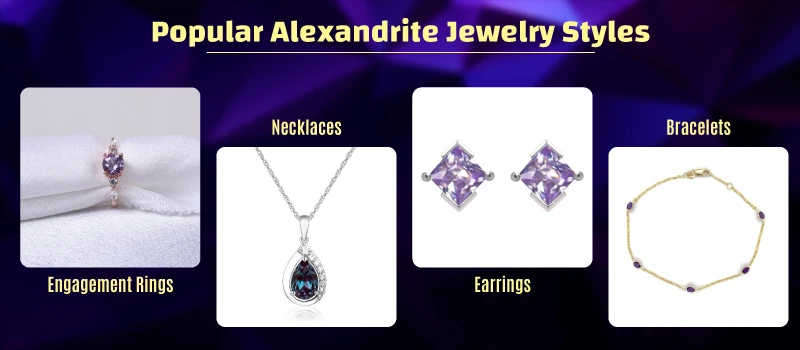
"In early June, the world of leaf and blade and flowers explodes, and every sunset is different." —John Steinbeck.

Alexandrite is a mind-bending gemstone that attracts you with its allure and sheer brilliance. It is famous for exhibiting the effect of color changeability, switching from bluish-green under daylight to purplish-red under artificial/night light, and its value depends on the extent of chromophore shift.
June Birthstone Alexandrite has various material types that cater to different tastes and prices. Natural Alexandrite is rare and costs more than most gemstones; even the lower-quality stones are expensive.
Even though they can be produced through synthesis techniques, the varieties produced in laboratories are a luxury with a steep price tag. Alexandrite is valued not only due to its scarcity but also for its spiritual and healing properties, such as emotional stability, creativity, subtle feelings, passion, new opportunities, and better blood circulation.

The origins of the Alexandrite Birthstone are rooted in Imperial Russia, named after Czar Alexander II. In 1834, miners searching for emeralds spotted it in the surroundings of the Tokovaya River in the inner Urals. Due to its red and green color, which resembled the Russian military colors, it became the official gemstone for the Imperial Russian Tsardom.
First believed to be emerald, Alexandrite's chameleon-like behavior delighted Russian jewelers and charmed Tiffany & Co.'s master gemologist, George Frederick Kunz, in the late 1800s and early 1900s. After the exhaustion of Alexandrite in Russia, it stopped being used in large numbers until supplies were discovered in Brazil in 1987.

Alexandrite was first found in the Ural Mountains region of Russia in 1830. However, at the end of the nineteenth century, Russia used up all the accessible Alexandrite. This mineral was later found in Brazil, India, and New Mexico.
The alexandrite mines in Brazil became notable in the late 1980s and early 1990s. Tanzania also has deposits, typically identified by the presence of diamonds and sapphires. Alexandrite was also found in Madagascar, India, Burma, and Zimbabwe. However, these locations have not yielded stones with the kind of vivid coloration as those Russian stones. Sri Lanka is another significant source known for its desirable gems.
Today, the primary sources for June birthstone alexandrite are Brazil and Sri Lanka, and the Ural Mountains yield only a small volume.
The formation of Alexandrite is a unique process that occurs when aluminum and beryllium oxide recrystallize with elements such as iron, titanium, and, most importantly, chromium. The vivid colors in the gem come from chromium, which causes the gem to change color depending on the light source.
When placed under direct sunlight, the gemstone alexandrite appears to be a shade of bluish-green, while when placed under artificial light, it seems to be purplish-red.
The mystic shine and the distinguishing characteristics of Alexandrite Birthstone serve as a unique selling proposition in today's jewelry design. Its high resistance enhances elegance and mystery in sophisticated earrings, shiny rings, slim bracelets, and beautiful necklaces. The unique attribute of Alexandrite is that it is viable during the day and at night, which makes it prized among connoisseurs of style who appreciate the exclusivity of materials.
The Alexandrite is one of the brightest of all gems and gives captivating appeal to any jewelry item. June Birthstone alexandrite comes in different metal finishes, thus fitting various styles for varying preferences and events.
Its growing popularity among gem lovers is because it complements today's trends by adding beauty to classic and casual wear, making bold fashion statements by exhibiting eye-popping color changes.
Fact: Alexandrites are nicknamed: “Emeralds of the Day, Ruby of the Night.”

To reap the benefits of Alexandrite healing properties and its versatility with any attire, this gem is often showcased in a variety of jewelry types, including:
This gemstone changes color depending on the direction of light that passes through it and is associated with transformation. This element makes it a favorite for those starting a new life phase, such as marriage.
Alexandrite can be used in many more styles and settings. It is best set in contrasting metals to create a remarkable look or with yellow or rose gold for a warm look. Alexandrite Jewelry is elegant in its simplicity and can easily fit into various themes and styles, making it a widely popular gemstone.
The phenomenon of color change in Alexandrite can be attributed to the gemstone's chemical composition. The crystal structure of the gemstone contains chromium ions, which enable it to absorb specific wavelengths of light selectively.
Thus, it is one of the few gems that can shift color depending on the lighting. Daylight or fluorescent light makes the Alexandrite appear greenish-blue. By night, it takes on a beautiful purplish-red hue under incandescent or candlelight.
Alexandrite healing properties make this gemstone more valuable in the occult field. It is believed that changing color occurs according to the wearer's health.
Some miraculous healing properties attributed to this stone are-
The caring and maintenance of the june birthstone Alexandrite includes the following points:
1. Be sure not to expose your precious June Birthstone Alexandrites to too much heat, as this may influence the color-changing process.
2. To clean the gemstone, the best practice is to use warm water and soap, avoiding harsh chemicals or abrasive scrubbing.
Pro Tip: Fracture-filled gemstones like Alexandrite are safe if ultrasonic and steam cleaners are not used; however, the best technique for cleaning fracture-filled gems is with warm, soapy water.
Alexandrite was discovered in the 1830s and was designated to signify the divine and earthly worldly.
The attributes that Alexandrite birthstone is associated with are:
| Wealth | Good Fortune | Wisdom |
|---|
At BOLD Precious Metals, we know how hard it is to discover ideal Alexandrite jewelry in a competitive market. Alexandrite is uncommon and intriguing due to its color-changing characteristics, yet establishing legitimacy and quality is difficult. We present a range of meticulously produced pieces that exhibit Alexandrite's stunning beauty and ensure authenticity.
BOLD has been a trusted dealer for over nine years, and our products are crafted with the utmost attention to detail! As one of the most relevant names in this industry, we take pride in presenting the finest collection of June birthstone alexandrite jewelry! These stunning pieces of jewelry are offered at the best market prices to make your purchase confident and hassle-free!
Explore the mesmerizing range of Alexandrite birthstone jewelry at BOLD and find the perfect piece for you or your loved ones!
There you have it, everything you need to know about the June Birthstone Alexandrite. Its unique ability to change color from greenish to purplish in different lighting situations has attracted much attention.
Another simple reason for its popularity is its symbolic connection with good fortune, good luck, and intelligence, transforming it into a valuable adornment for any jewelry collection. Whether as a gift or a self-pampering accessory, Alexandrite signifies elegance and the element of charm in jewelry.
Celebrate your birthday or gift it to your loved ones born in this month with ‘June Birthstone Alexandrite’!